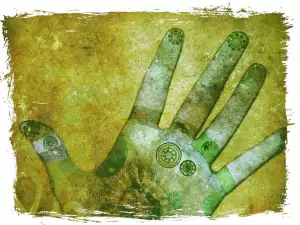In the middle of 2005, I took my first trip to Mumbai (Bombay) and had the exclusive opportunity to obtain secretive books, containing even more secretive subjects, that can be found on the Indian subcontinent. It turned out that the books weren't as amazing as I had assumed.
I found a book called "Investigating Palmistry". It contained a long and valuable lesson dealing with the interpretation of the fingers of the hand, which I found appropriate to share here. Even though the book itself did not contain classical Indian palmistry (it was written by a French palmist by the name of Comte de Saint Germain), it portrayed the main Indian religious systems and how they relate to the hand.
The way the book was written - in wonderful, silly, Indian-English, made me suspect that Comte de Saint Germain could in reality have been Indian! What was even more interesting, when I returned to the hotel in Mumbai and showed the personnel what I bought from my expedition to the book sellers, they all showed me their own palms and the interpretations as revealed by the lines.
It turns out that in India, everyone believes in palmistry, even the porters and valets in the hotels - in India, palmistry is for the masses, and not just another pastime for the middle class, as it is in the West. That which makes India so wonderful is that it's spiritual, despite its poverty!
What meanings do your thumbs and fingers reveal? According to the author of the aforementioned book, palmistry does not include the study of the thumbs, which have the honor of being the subject of a different study.
Therefore, palmistry only includes the study of the 4 fingers of the hand, which are labelled as follows:
The first finger or index finger, finger of Jupiter.
The second finger or middle finger, finger of Saturn.
The third finger or ring finger, finger of Apollo.
The fourth finger or pinky, finger of Mercury.
And the thumb? All modern palmists pay so much attention to the position and form of the thumb, that it seems important for me to mention why.
All higher forms of animals are distinguished by the fact that they have hands. Humans are distinguished by having thumbs. The thumbs of monkeys are almost immovable and for this reason, are not opposable (they cannot work together with the other fingers), which is why it's thought of by many biologists as just another movable nail.
In humans, the opposite is true. The thumb is so well positioned that it has the capability to always function in the opposite direction of the other fingers, and it is this very ability that symbolizes the moral feeling, which we place opposite our will and through it, the temptations of our instincts and senses.
More from Palmistry: Fingers and the Hand
The ring finger
The middle finger
Structure of the hand
Finger size
More from Palmistry: Lines of the Hand
The line of Marriage
The line of Life
The line of Reasoning









